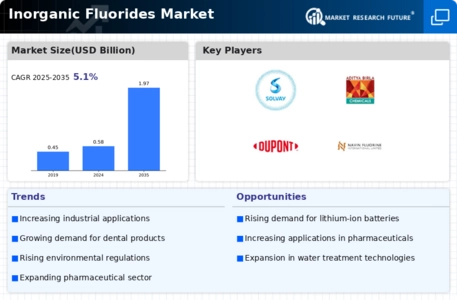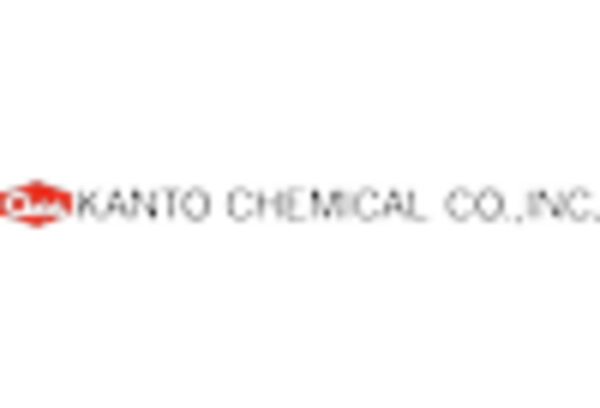-
Executive Summary
-
Market Introduction
-
Market Definition
-
Scope of the
- Research
- Assumptions & Limitations
-
Study
-
Objectives
-
Markets Structure
-
Key Takeaways
-
Market Research Methodology
-
Research Process
-
Primary Research
-
Secondary Research
-
Market Size Estimation
-
Forecast Model
-
Market Dynamics of the Global Inorganic
-
Fluorides Market
-
Introduction
-
Drivers
-
Restraints
-
Opportunities
-
Challenges
-
Trends/Technology
-
Market Factor Analysis of the
-
Global Inorganic Fluorides Market
-
Supply
- Raw Material Suppliers
- Manufacturers/Producers
- Distributors/Retailers/Wholesalers/E-Commerce
-
Chain Analysis
-
End-User
-
Porter’s
- Threat of New
- Bargaining Power of Buyers
- Bargaining Power of Suppliers
- Threat of Substitutes
-
Five Forces Analysis
-
Entrants
-
Intensity of Rivalry
-
Pricing Analysis
-
Global Inorganic Fluorides Market, by Product
-
Introduction
-
Calcium Fluoride
- Market Estimates & Forecast, 2020−2027
-
Market Estimates & Forecast, by Region, 2020−2027
-
Hydrogen Fluoride
-
Market Estimates & Forecast, 2020−2027
-
Estimates & Forecast, by Region, 2020−2027
-
Fluoride
-
Estimates & Forecast, 2020−2027
-
Forecast, by Region, 2020−2027
-
Market
-
Sodium
- Market
- Market Estimates &
-
Others
- Market Estimates & Forecast,
- Market Estimates & Forecast, by Region, 2020−2027
-
Global Inorganic Fluorides Market, by End Use
-
Introduction
-
Agrochemicals
- Market Estimates & Forecast,
- Market Estimates & Forecast, by Region, 2020−2027
-
Water Treatment
- Market Estimates &
- Market Estimates & Forecast, by
-
Forecast, 2020−2027
-
Region, 2020−2027
-
Aluminum
- Market
- Market Estimates &
-
Estimates & Forecast, 2020−2027
-
Forecast, by Region, 2020−2027
-
Orthodontic Consumables
- Market Estimates & Forecast, 2020−2027
-
Market Estimates & Forecast, by Region, 2020−2027
-
Electronics
-
Others
-
Market Estimates & Forecast, 2020−2027
-
Market Estimates & Forecast, by Region, 2020−2027
-
Market Estimates & Forecast, 2020−2027
-
Market Estimates & Forecast, by Region, 2020−2027
-
Global Inorganic Fluorides Market, by Region
-
Introduction
-
North America
- Market Estimates &
- Market Estimates & Forecast,
- Market Estimates & Forecast,
- US
- Canada
-
Forecast, 2020−2027
-
by Product, 2020−2027
-
by End Use, 2020−2027
-
& Forecast, by Product, 2020−2027
-
Market Estimates & Forecast, 2020−2027
-
Market Estimates & Forecast, by End Use, 2020−2027
-
Europe
-
Forecast, by Product, 2020−2027
-
Forecast, by Product, 2020−2027
-
by Product, 2020−2027
-
Spain
-
Market Estimates & Forecast, 2020−2027
-
& Forecast, by End Use, 2020−2027
-
& Forecast, 2020−2027
-
Forecast, by End Use, 2020−2027
-
Forecast, 2020−2027
-
Forecast, by End Use, 2020−2027
-
Forecast, 2020−2027
-
& Forecast, by End Use, 2020−2027
-
of Europe
-
Market Estimates & Forecast, 2020−2027
-
Market Estimates & Forecast, 2020−2027
-
Market Estimates & Forecast, by Product, 2020−2027
-
Market Estimates & Forecast, by End Use, 2020−2027
-
Germany
-
Market Estimates & Forecast, 2020−2027
-
Market Estimates &
-
Market Estimates & Forecast, by End Use, 2020−2027
-
France
-
Market Estimates & Forecast, 2020−2027
-
Market Estimates &
-
Market Estimates & Forecast, by End Use, 2020−2027
-
Italy
-
Market Estimates & Forecast, 2020−2027
-
Market Estimates & Forecast,
-
Market Estimates & Forecast, by End Use, 2020−2027
-
Market Estimates & Forecast, by Product,2020−2027
-
Market Estimates
-
UK
-
Market Estimates
-
Market Estimates & Forecast, by Product,2020−2027
-
Market Estimates &
-
Russia
-
Market Estimates &
-
Market Estimates & Forecast, by Product,2020−2027
-
Market Estimates &
-
Poland
-
Market Estimates &
-
Market Estimates & Forecast, by Product, 2020−2027
-
Market Estimates
-
Rest
-
Market Estimates & Forecast, by Product,
-
Market Estimates & Forecast, by End Use, 2020−2027
-
Asia-Pacific
-
Use, 2020−2027
-
Market Estimates & Forecast,
-
Market Estimates & Forecast, by Product,
-
Market Estimates & Forecast, by End
-
China
-
Market Estimates & Forecast,
-
Market Estimates & Forecast, by Product, 2020−2027
-
& Forecast, by End Use, 2020−2027
-
& Forecast, 2020−2027
-
& Forecast, by End Use, 2020−2027
-
& Forecast, 2020−2027
-
& Forecast, by End Use, 2020−2027
-
& New Zealand
-
Market Estimates & Forecast, 2020−2027
-
by Product, 2020−2027
-
& Forecast, by Product, 2020−2027
-
Middle East & Africa
-
Forecast, 2020−2027
-
by Product, 2020−2027
-
by End Use, 2020−2027
-
& Forecast, by Product, 2020−2027
-
by Product, 2020−2027
-
Forecast, by Product, 2020−2027
-
Forecast, by Product, 2020−2027
-
& Forecast, by Product, 2020−2027
-
Forecast, 2020−2027
-
by Product, 2020−2027
-
by End Use, 2020−2027
-
Forecast, 2020−2027
-
Forecast, by End Use, 2020−2027
-
& Forecast, 2020−2027
-
Forecast, by End Use, 2020−2027
-
& Forecast, 2020−2027
-
Forecast, by End Use, 2020−2027
-
America
-
Market Estimates & Forecast, 2020−2027
-
Market Estimates
-
India
-
Market Estimates
-
Market Estimates & Forecast, by Product, 2020−2027
-
Market Estimates
-
Japan
-
Market Estimates
-
Market Estimates & Forecast, by Product, 2020−2027
-
Market Estimates
-
Australia
-
Market Estimates & Forecast,
-
Market Estimates & Forecast, by End Use, 2020−2027
-
Rest of Asia-Pacific
-
Market Estimates & Forecast, 2020−2027
-
Market Estimates
-
Market Estimates & Forecast, by End Use,
-
Market Estimates &
-
Market Estimates & Forecast,
-
Market Estimates & Forecast,
-
GCC
-
Market Estimates & Forecast, 2020−2027
-
Market Estimates
-
Market Estimates & Forecast, by End Use, 2020−2027
-
Israel
-
Market Estimates & Forecast, 2020−2027
-
Market Estimates & Forecast,
-
Market Estimates & Forecast, by End Use, 2020−2027
-
North Africa
-
Market Estimates & Forecast, 2020−2027
-
Market Estimates &
-
Market Estimates & Forecast, by End Use, 2020−2027
-
Turkey
-
Market Estimates & Forecast, 2020−2027
-
Market Estimates &
-
Market Estimates & Forecast, by End Use, 2020−2027
-
Rest of Middle East & Africa
-
Market Estimates & Forecast, 2020−2027
-
Market Estimates
-
Market Estimates & Forecast, by End Use, 2020−2027
-
Latin America
- Market Estimates &
- Market Estimates & Forecast,
- Market Estimates & Forecast,
- Brazil
- Argentina
- Mexico
- Rest of Latin
-
Market Estimates & Forecast, by End Use, 2020−2027
-
Company Landscape
-
Introduction
-
Market Strategy
-
Key Development Analysis (Expansion/Merger & Acquisitions/Joint Venture/New
-
Product Development/Agreement/Investment)
-
Company
-
Profiles
-
Solvay
- Company Overview
- Financial Updates
- Key Developments
- SWOT Analysis
-
Product/Business Segment Overview
-
Strategy
-
Aditya
- Company Overview
- Strategy
- Key Developments
-
Birla Chemicals
-
Financial Updates
-
Product/Business Segment Overview
-
SWOT Analysis
-
Honeywell International Inc.
- Financial Updates
- Product/Business Segment Overview
- Strategy
- SWOT Analysis
- Company Overview
- Strategy
- Key Developments
-
Company Overview
-
Key Developments
-
Do-Fluoride Chemicals Co., Ltd
-
Financial Updates
-
Product/Business Segment Overview
-
SWOT Analysis
-
Arkema S.A.
- Company Overview
- Financial Updates
- Key Developments
- SWOT Analysis
-
Product/Business Segment Overview
-
Strategy
-
Navin
- Company Overview
- Financial Updates
- Key Developments
- SWOT Analysis
-
Fluorine International Limited
-
Product/Business Segment Overview
-
Strategy
-
Alfa
- Company Overview
- Strategy
- Key Developments
-
Aesar
-
Financial Updates
-
Product/Business Segment Overview
-
SWOT Analysis
-
Shanghai Mintchem Development CO.,
- Company Overview
- Strategy
- Key Developments
-
Ltd.
-
Financial Updates
-
Product/Business Segment Overview
-
SWOT Analysis
-
fluorides and
- Company Overview
- Product/Business
- Strategy
- SWOT Analysis
-
chemicals
-
Financial Updates
-
Segment Overview
-
Key Developments
-
DuPont de Nemours, Inc.
- Company Overview
- Financial Updates
- Key Developments
- SWOT Analysis
-
Product/Business Segment Overview
-
Strategy
-
shandong dongyue chemical co., ltd
- Company Overview
- Strategy
- Key Developments
- SWOT
-
Financial Updates
-
Product/Business Segment Overview
-
Analysis
-
DAIKIN INDUSTRIES, Ltd.
- Company
- Financial Updates
- Product/Business Segment Overview
- Key Developments
- SWOT Analysis
-
Overview
-
Strategy
-
Conclusion
-
LIST OF TABLES
-
Global
-
Inorganic Fluorides Market: by Region, 2020−2027
-
Table 2
-
North America: Inorganic Fluorides Market, by Country, 2020−2027
-
Europe: Inorganic Fluorides Market, by Country, 2020−2027
-
Asia-Pacific: Inorganic Fluorides Market. by Country,
-
Middle East & Africa: Inorganic
-
Fluorides Market, by Country, 2020−2027
-
Latin
-
America: Inorganic Fluorides Market, by Country, 2020−2027
-
Table 7
-
Global Inorganic Fluorides Product Market, by Regions, 2020−2027
-
North America: Inorganic Fluorides Product Market, by
-
Country, 2020−2027
-
Europe: Inorganic Fluorides
-
Product Market, by Country, 2020−2027
-
Table10 Asia-Pacific:
-
Inorganic Fluorides Product Market, by Country, 2020−2027
-
Table11
-
Middle East & Africa: Inorganic Fluorides Product Market, by Country,
-
Table12 Latin America: Inorganic Fluorides
-
Product Market, by Country, 2020−2027
-
Table13 Global
-
Inorganic Fluorides End Use Market, by Regions, 2020−2027
-
Table14
-
North America: Inorganic Fluorides End Use Market, by Country, 2020−2027
-
Table15 Europe: Inorganic Fluorides End Use Market, by Country,
-
Table16 Asia-Pacific: Inorganic Fluorides
-
End Use Market, by Country, 2020−2027
-
Table17 Middle
-
East & Africa: Inorganic Fluorides End Use Market, by Country, 2020−2027
-
Table18 Latin America: Inorganic Fluorides by End Use Market,
-
by Country, 2020-2027
-
Table19 Global Product Market, by Region,
-
Table20 Global End Use Market, by Region,
-
Table21 North America: Inorganic Fluorides
-
Market, by Country, 2020−2027
-
Table22 North America:
-
Inorganic Fluorides Market, by Product, 2020−2027
-
Table23
-
North America: Inorganic Fluorides Market, by End Use, 2020−2027
-
Table24 Europe: Inorganic Fluorides Market, by Country, 2020−2027
-
Table25 Europe: Inorganic Fluorides Market, by Product, 2020−2027
-
Table26 Europe: Inorganic Fluorides Market, by End Use, 2020−2027
-
Table27 Asia-Pacific: Inorganic Fluorides Market,
-
by Country, 2020−2027
-
Table28 Asia-Pacific:
-
Inorganic Fluorides Market, by Product, 2020−2027
-
Table29
-
Asia-Pacific: Inorganic Fluorides Market, by End Use, 2020−2027
-
Table30 Middle East & Africa: Inorganic Fluorides Market,
-
by Country, 2020−2027
-
Table31 Middle East & Africa:
-
Inorganic Fluorides Market, by Product, 2020−2027
-
Table32
-
Middle East & Africa: Inorganic Fluorides Market, by End Use, 2020−2027
-
Table33 Latin America: Inorganic Fluorides Market, by Country,
-
Table34 Latin America: Inorganic Fluorides
-
Market, by Product, 2020−2027
-
Table35 Latin America:
-
Inorganic Fluorides Market, by End Use, 2020−2027
-
LIST OF
-
FIGURES
-
Global Inorganic Fluorides Market Segmentation
-
Forecast Research Methodology
-
FIGURE 3
-
Five Forces Analysis of the Global Inorganic Fluorides Market
-
FIGURE 4
-
Value Chain of the Global Inorganic Fluorides Market
-
FIGURE 5
-
Global Inorganic Fluorides Market, 2020−2027, by Country, 2020
-
FIGURE
-
Share of the Global Inorganic Fluorides Market, by Product, 2020−2027
-
Global Inorganic Fluorides Market Size, by Product, 2020
-
Share of the Global Inorganic Fluorides Market, by Product,
-
Global Inorganic Fluorides Market Size,
-
by End Use, 2020
-
FIGURE10 Share of the Global Inorganic Fluorides Market,
-
by End Use, 2020−2027

















Leave a Comment